As we mark the 50th anniversary of one of Man’s greatest endeavours, the lunar landing of 20th July 1969, Gareth Stringer looks at the aviation foundations of the three men who flew on Apollo 11’s historic mission to the moon. Images as credited.
Apollo 11 lifted off at 9.32am (EDT) on 16th July 1969 from Kennedy Space Centre’s Launch Complex 39A, commencing the mission that, four days later, would see humans set foot on an entity other than earth for the very first time. It will forever remain one of history’s most iconic and memorable moments – and our greatest achievements.
Twelve men walked on the moon in total and the first to do so were of course Apollo 11’s mission Commander Neil Amstrong and Edwin “Buzz” Aldrin Jr, Lunar Module Pilot. Joining them on their historic adventure, albeit not on the descent to the moon, was Command Module Pilot Michael Collins.

The crew of Apollo 11 – (L to R) Neil Armstrong, Michael Collins and Buzz Aldrin – NASA
The last man to walk on the moon was Gene Cernan. He and his Apollo 17 colleague Harrison Schmitt left the lunar surface on 14th December 1972 to rejoin their Command Module Pilot Ronald Evans for the 240,000 mile journey back to earth. That we have yet to return is naturally a topic of discussion as we celebrate the 50th anniversary of Apollo 11 this summer and, having missed out the first time, I sincerely hope that it is an adventure I get to see repeated in my lifetime as a result of NASA’s recently-announced Project Artemis, named after the Greek / Roman God Apollo’s sister.
My own personal interest in the space race was triggered when I watched the movie adaptation of, and subsequently read, Tom Wolfe’s seminal book ‘The Right Stuff‘ which tells the tale of America’s quest to break the sound barrier and then, lagging behind the Russians in the ultra-competitive Cold War, to put a man into space, in a capsule called Mercury, mounted atop of a rocket designed not for orbital or even sub-orbital flight, but as a ballistic missile.
Central to this story is the selection of America’s first astronauts and, to a man, the ‘Mercury 7’ as they became known, were all test pilots, as it had been decreed that they and they alone were best suited for space travel and all the physical and physiological stresses that it was thought would go with it. I say ‘thought’ because in the beginning of this process no one really knew what would happen to the human body in space. It might seem remarkable now, but there was even speculation from some scientific quarters that it might prove instantly fatal.
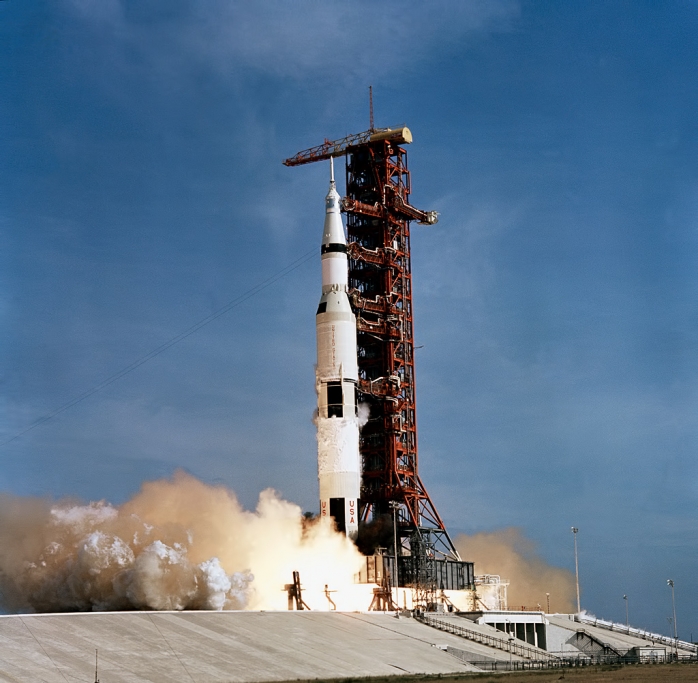
Lift off for Apollo 11 on 16th July 1969 – NASA
That selection policy would continue through the second intake of astronauts (dubbed the “Next Nine” and which included Armstrong) and into the third (christened “The Fourteen” – Aldrin and Collins were selected here) although test pilot experience was waived as a requirement for this group and a minimum of 1,000 hours of military fast jet experience could be used as a substitute.
The fourth group (“The Scientists”) was chosen based on research and academic experience, with NASA providing pilot training as necessary. It was from this group of that Schmitt would eventually find himself walking on the moon.

Aldrin on the surface of the moon – NASA
This entire era was of course a golden one in terms of aviation innovation and flight test, with record-breaking prototypes flying higher and faster than ever before and a whole host of manufacturers designing and building aircraft for the military, many of which would never enter into frontline service and a number of which, as the edges of the envelope were pushed and explored, looked like nothing seen before, or since.
These were the aircraft that the Project Mercury, Gemini and then Apollo astronauts flew before becoming astronauts and I wanted to take a closer look at the Apollo 11 mission from an aviation standpoint and, specifically, at some of the aircraft types most closely associated with the careers of the three men who made history in 1969.
Neil Armstrong – Commander
Neil Armstrong was born in 1930 and was awarded his pilot’s licence at the age of 16. He graduated from high school in 1947 and, with a scholarship from the US Navy, enrolled at Purdue University to study aeronautical engineering. In 1949 he was summoned to active duty and trained to become a military pilot.
Armstrong’s flight training was conducted in the North American SNJ trainer and he went solo in this aircraft on 9th September 1949. On 2nd March 1950 he completed his first aircraft carrier landing on the USS Cabot, an achievement that Armstrong later said that he considered comparable to his first solo flight back in 1946. His next stop was Naval Air Station Corpus Christi in Texas for training on the Grumman F8F Bearcat and on 16th August 1950 Armstrong officially became a fully qualified naval aviator.

Ensign Neil Armstrong flying Grumman F9F-2 Panther 125122 number 116 for VF-51 – US Naval Aviation Museum
In November 1950 he was assigned to VF-51 and he made his first flight in a jet, a Grumman F9F Panther, in January 1951. In June he made his first jet carrier landing aboard USS Essex which then set sail for Korea, with VF-51 and its Panthers on-board to act as ground-attack aircraft. Armstrong and his colleagues flew ahead to NAS Barbers Point in Hawaii and completed fighter-bomber training before rejoining the ship at the end of July.
The Grumman F9F Panther is an aircraft of great historical importance for the US Navy as it was one of the first carrier-based jet fighters to achieve significant success. It was also Grumman’s first ever jet-powered combat aircraft; a single-engine, straight-winged fighter bomber, armed with four 20mm cannons and the ability to carry a broad selection of air-to-ground ordinance.
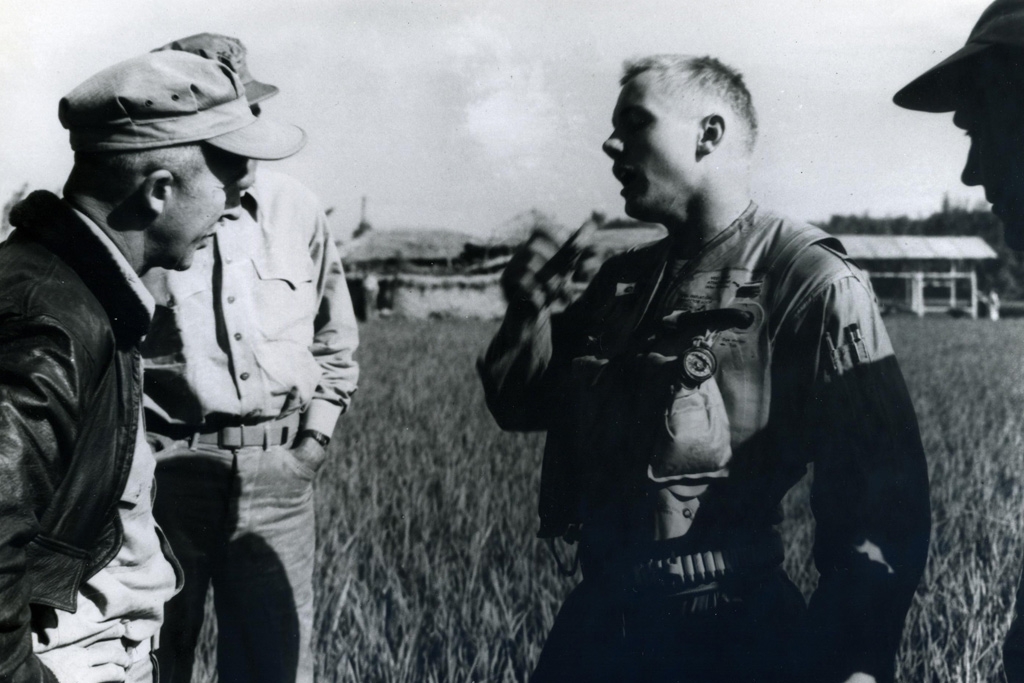
After bailing out of his Grumman Panther over Pohang Airfield in September 1951, Neil Armstrong, still holding the D-ring from his ripcord, chats with local Marines, including an old friend from flight school! US Navy / Public Domain
Used extensively by both the US Navy and US Marine Corps in the Korean War, it was also the first jet aircraft used by the Blue Angels demonstration team. More than 1,300 Panthers were produced, and the aircraft’s design would evolve into the swept-wing Grumman F-9 Cougar.
Armstrong flew 78 missions over Korea including one which ended up with him bailing out when his aircraft took damage on a bombing run. His flew his final mission on 5th March 1952 and received the Air Medal (for 20 combat missions), two gold stars (for the next 40 combat missions), the Korean Service Medal and Engagement Star, the National Defense Service Medal and the United Nations Korea Medal.
His regular commission was terminated after Korea and he enrolled with the US Navy Reserves before returning to university to complete his studies, graduating with a bachelor’s degree in Aeronautical Engineering in 1955.
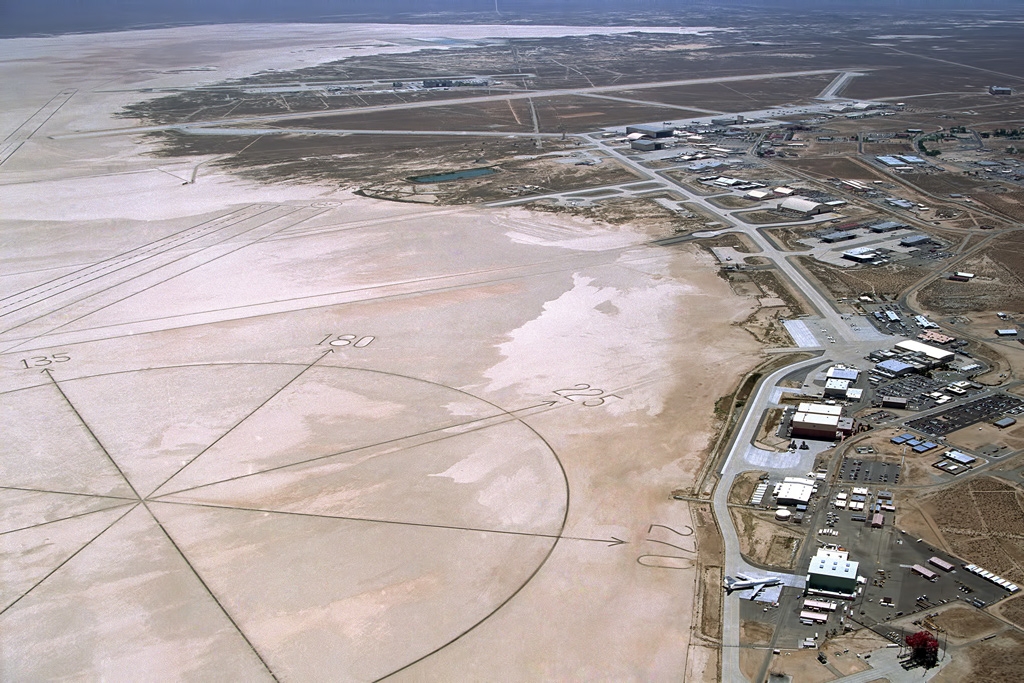
The Neil A.Armstrong Flight Research Center – USAF
On completion of his studies Armstrong successfully applied for a job at the NACA High Speed Flight Station based at Rogers Dry Lake Bed, which was part of Edwards Air Force Base in California. The facility is still based at Edwards to this day and can be found on the north western edge of the lake bed, just south of the base’s North Gate. As NASA’s main installation for atmospheric flight testing it researches and develops earth and space flight operations.
The centre has been through a dizzying array of name changes and, prior to Armstrong’s arrival, had already been known as the National Advisory Committee for Aeronautics (NACA) Muroc Flight Test Unit (1946), the NACA High-Speed Flight Research Station (1949) and then the NACA High-Speed Flight Station (1954). It would later be called the National Aeronautics and Space Administration (NASA) High Speed Flight Station (1958), NASA Flight Research Center (1959) and, from 1976, the Dryden Flight Research Center, in honour of Hugh L Dryden, a prominent aeronautical engineer who had been NASA’s deputy administrator.
In March 2014 the facility was renamed once more, but this time in honour of Neil Armstrong.
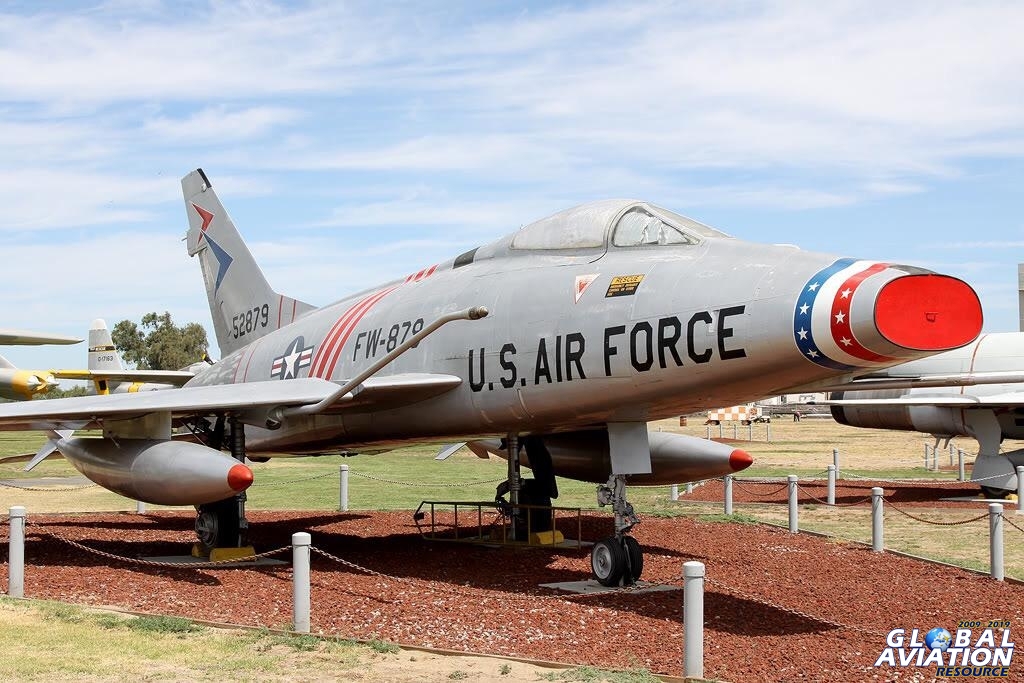
This aircraft is the very first F-100C and was flown by Neil Armstrong – it can now be seen at Castle Air Museum © Paul Dunn – Global Aviation Resource
Armstrong’s first role at the facility was as a project pilot on the North American F-100A and F-100C Super Sabre, McDonnell F-101 Voodoo and the Lockheed F-104A Starfighter, each type coming from the extraordinary Century Series of aircraft that comprises the models designated from F-100 to F-106, all of which went into full production and included the first truly successful supersonic aircraft designs in United States Air Force (USAF) service.
The North American F-100 Super Sabre served with USAF from 1954 to 1971 and with the Air National Guard (ANG) until 1980, with the type also serving with the air forces of Taiwan, Denmark, France, and Turkey. It was the first USAF fighter capable of reaching supersonic speed in level flight. Designed by North American Aviation, the F-100 was a high performance successor to the F-86 Sabre, more of which later, and the Super Sabre was actually flown by all three of Apollo 11’s crew members.

F-101B Voodoo – Air Defense Weapons Center – Tyndall AFB -10/80 © Lindsay Peacock – Global Aviation Resource
Adapted as a fighter-bomber, the F-100 flew extensively over South Vietnam as the Air Force’s primary close air support jet until it was replaced by the F-4 Phantom, F-105 Thunderchief and A-7 Corsair II. The last Super Sabre left Vietnam in July 1971 by which time the type had logged a mammoth 360,283 combat sorties with 242 examples lost, 186 of which fell to North Vietnamese anti-aircraft defences but none to enemy aircraft. In its later life it was often referred to as ‘The Hun’, an abbreviated version of ‘One Hundred’, and in 1972 the last USAF F-100s were transferred to ANG squadrons which used the aircraft until its retirement.
Having been initially designed by McDonnell Aircraft as a long-range bomber escort for Strategic Air Command, the F-101 Voodoo that Armstrong also tested was instead developed as a nuclear-armed fighter-bomber for Tactical Air Command and as a photo reconnaissance aircraft. It’s time in service was relatively limited although the RF-101 reconnaissance variant was instrumental during the Cuban Missile Crisis and saw extensive service during the Vietnam War, but the Voodoo retired in 1972 from USAF and 1982 from the ANG.
It has been suggested that perhaps its greatest success was as a stepping stone to the legendary McDonnell Douglas F-4 Phantom but the F-101 did also go on to serve with the Royal Canadian Air Force until 1984. The Voodoo was sometimes known by the nickname ‘one-oh-wonder’ and this was often reflected on the patches worn by its units and crews.
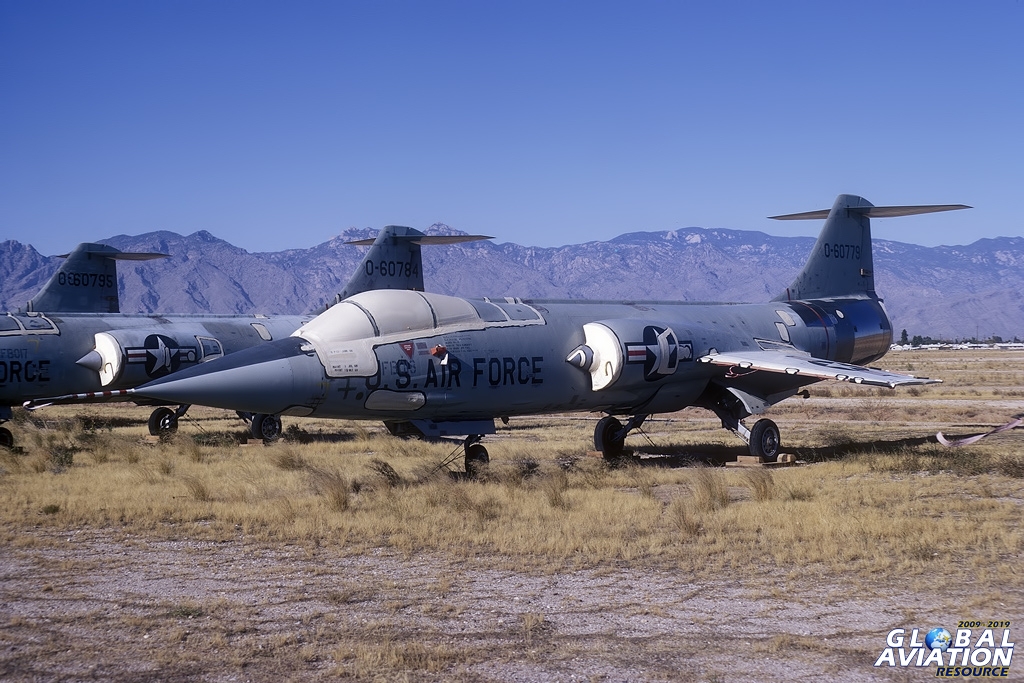
F-104A Starfighter – 60779 – Davis-Monthan – 11/69 © Lindsay Peacock – Global Aviation Resource
Finally, from the initial batch of aircraft that Neil Armstrong flew on a regular basis we reach the legendary Lockheed F-104 Starfighter; a single-engine, supersonic interceptor aircraft originally developed for the United States Air Force. Nicknamed ‘the missile with a man in it’, a moniker which Lockheed actually trademarked and used for marketing materials, the F-104 would later be produced under licence by several other nations and saw widespread service outside the United States where it was operated by the air forces of more than a dozen countries from 1958 to 2004.
Its design team was led by the great Kelly Johnson, who contributed so much to the development of the P-38 Lightning, U-2 and SR-71 Blackbird, to name but a few, and the F-104 set numerous airspeed and altitude world records and is linked not just to Neil Armstrong but also to Michael Collins who, as we will see later, flew the Starfighter when he was an experimental test pilot. On 18 May 1958 an F-104A, like that pictured above, set a (then) world speed record of 1,404.19mph or 2,259.82km/h.
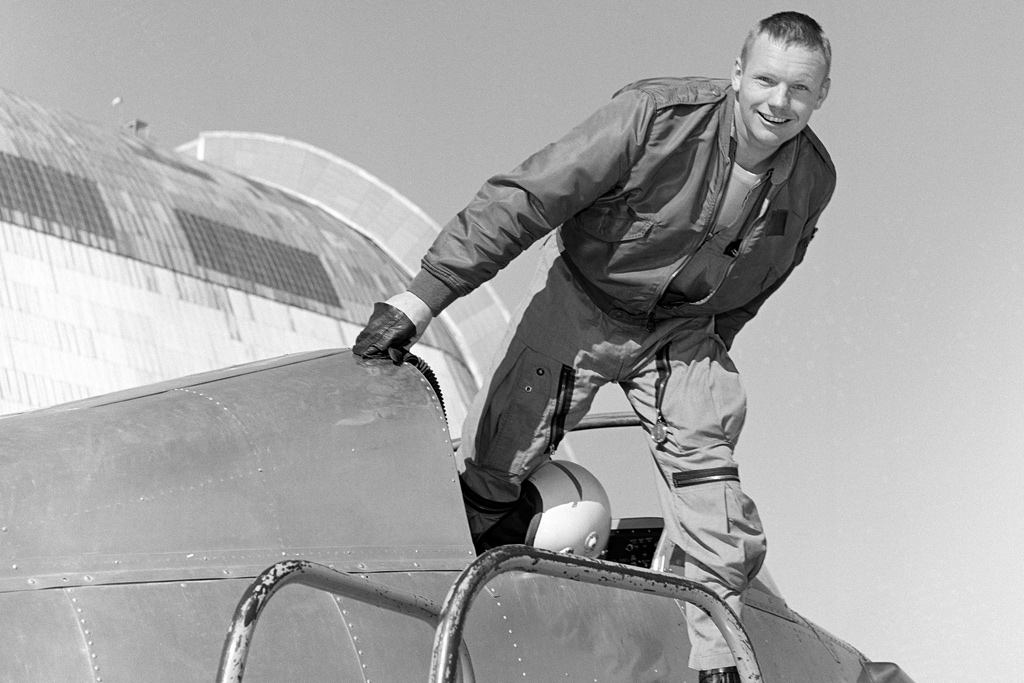
Neil Armstrong in the cockpit of the Bell X-14 – February 1964 – NASA
Unlike his Apollo 11 colleagues, Armstrong’s time as a civilian test pilot would enable him to fly some of the famous X-Planes, this being the series of experimental American aircraft and rockets that were used to test and evaluate new technologies and aerodynamic concepts. The X designation denoted that their mission was one of research and development and it is here that we find some of the most extraordinary and unique designs of this, or indeed any era.
During his time as a test pilot Armstrong flew the X-1B, X-5, X-14 and X-15.
The Bell X-1B was a development of the X-1 in which Charles ‘Chuck’ Yeager had been the first man to achieve supersonic flight in October 1947. It was utilised for high-speed research by USAF in October 1954 and was transferred to NACA in January 1955 where it continued to fly until January 1958 when cracks were discovered in the fuel tanks and it was grounded. The X-1B completed a total of 27 flights and can now be seen at the National Museum of the United States Air Force at Wright-Patterson Air Force Base in Dayton, Ohio, where it is displayed in the Research and Development Gallery.
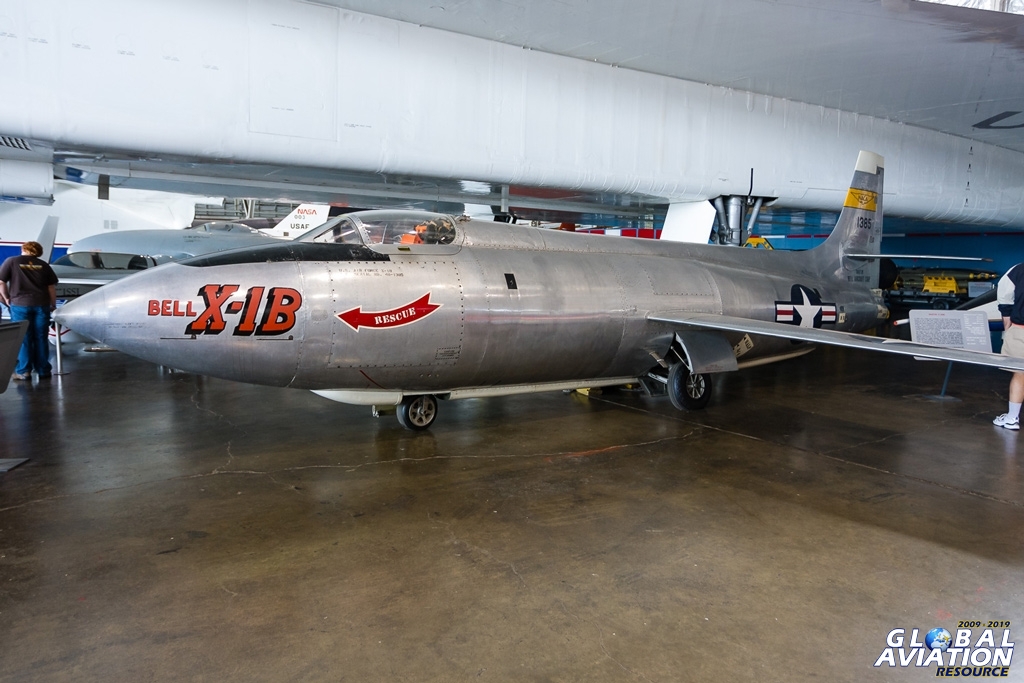
Bell X-1B – National Museum of the United States Air Force © Rob Edgcumbe – Global Aviation Resource
The first aircraft capable of adjusting its wing sweep in flight (see the gallery at the end of this feature), two Bell X-5 aircraft were built and both flew for the first time in 1951. Almost 200 test flights were made at speeds up to Mach 0.9 and altitudes of 40,000 ft but one X-5 was lost in 1953, killing USAF Captain Ray Popson in a crash at Edwards Air Force Base. This accident was due to the X-5’s flawed aerodynamic layout, particularly its poorly positioned tail and vertical stabiliser which, in some wing-sweep positions, could lead to a violent and irrecoverable spin.
The other X-5 remained at Edwards and continued to participate in active testing until 1955 when Armstrong made his single flight in the jet, which was actually the last in its test programme. It remained in service as a chase plane until 1958 and now resides alongside the X-1B at Wright-Patterson’s Air Force Museum.
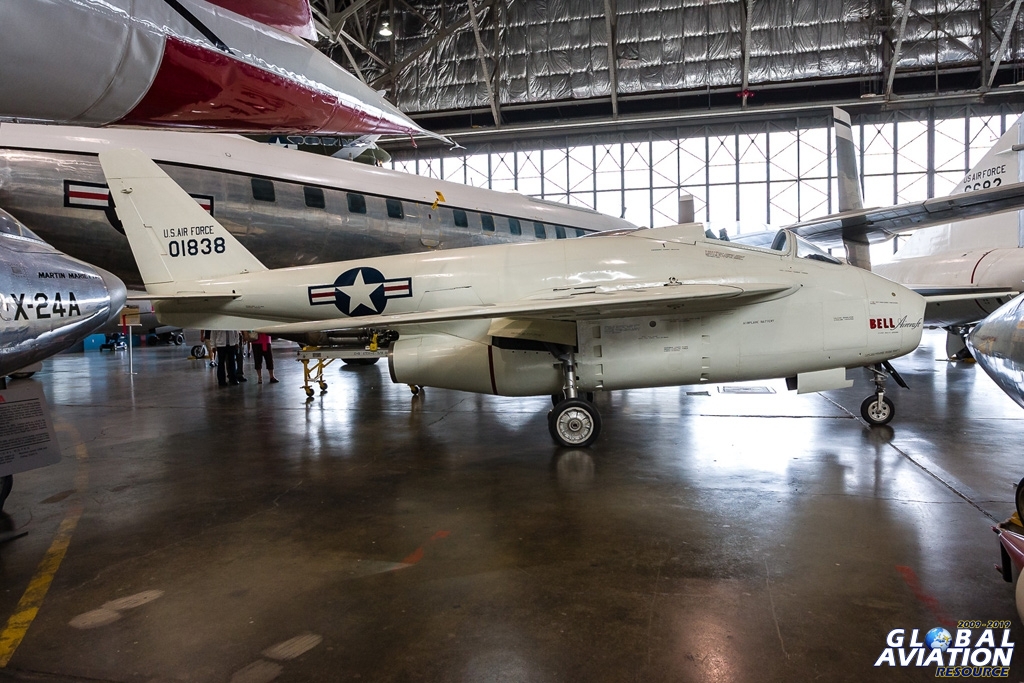
Bell X-5 – National Museum of the United States Air Force © Rob Edgcumbe – Global Aviation Resource
Just one example of the X-14 was manufactured, or rather, assembled from a collection of parts. A very special test aircraft, the X-14 was only X-Plane to fly without a canopy and became the basic trainer for the first Apollo astronauts learning to touchdown on the moon’s surface. The X-14A was built from existing airframe and engine components and was designed to explore the VTOL (Vertical Take Off and Landing) flight envelope while astronauts also utilised the infamous Lunar Landing Training Vehicle, the flying bedstead, that Armstrong ejected from during training for Apollo 11.
X-14 components included the wings of a Beechcraft Bonanza, the fuselage and landing gear from a Beechcraft T-34 and two horizontally mounted Armstrong Siddeley Viper Viper engines (similar to those found in a Jet Provost, among other types) that were equipped with thrust deflectors, although these were later updated to General Electric J85-GE-19 engines for better hover performance in what was called the X-14B.
Twenty-five pilots, such as Harrier test pilots and various Apollo astronauts, including Armstrong, were reported to have flown the X-14 to experience VTOL flight parameters and simulate moon landings. The X-14B was used until it was damaged beyond repair in a landing accident on 29th May 1981 and the sole example was being restored by Fred Ropkey in his Armor Museum at Ropkey Private Airport in Crawfordsville, Indiana, but the museum closed in 2017 following Fred’s death. The X-14’s current whereabouts is unknown, although the collection was (is?) apparently being sold off.

X-14B – Armor Museum at Ropkey Private Airport in Crawfordsville © Paul Hannah – www.vgbimages.com
In November 1960, Armstrong made his first flight in the high performance North American X-15, going on to make a total of seven flights in the iconic rocket plane, reaching a personal record altitude of 207,500 feet in the X-15-3 and a highest Mach number of 5.74 (3,989 mph) in the X-15-1. The X-15 set various speed and altitude records in the 1960’s and thirteen of its 199 flights would reach the edge of outer space, providing hugely valuable data which would be used to benefit aircraft and spacecraft design.
Those thirteen flights were carried out by eight different pilots, each one of whom met the Air Force’s spaceflight criteria having exceeded an altitude of 50 miles. That immediately qualified them as astronauts and they were awarded with astronaut wings as a result. There was however no such rule for civilian pilots who met the same criteria, but NASA research pilots William H. “Bill” Dana, John B. “Jack” McKay and Joseph A. Walker were finally honoured with their NASA astronaut wings in 2005, McKay and Walker posthumously.
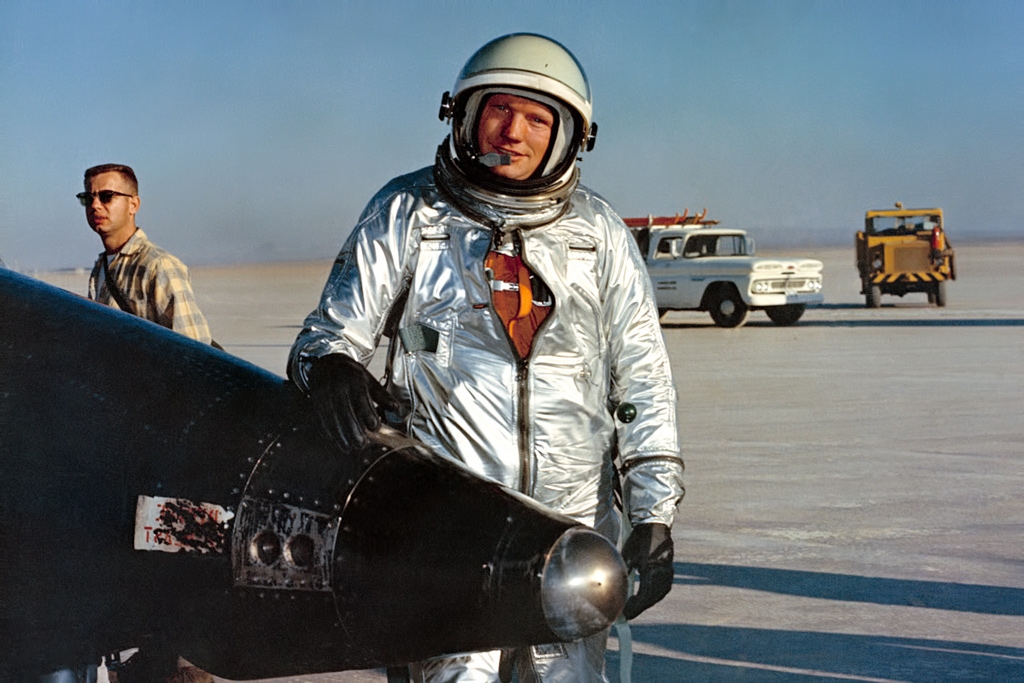
Neil Armstrong after an X-15 flight – NASA
The X-15’s official world record for the highest speed ever recorded by a manned, powered aircraft was set in October 1967 when William J. “Pete” Knight flew at a speed of Mach 6.70 at 102,100 feet. This equates to a speed of 4,520 miles per hour or 7,274 km/h (that’s 2,021 m/s!) and, at the time of writing, this record remains unbroken.
Today, X-15-1 (56-6670) is on display in the National Air and Space Museum ‘Milestones of Flight’ gallery, Washington, D.C, while X-15-2 (56-6671) can be seen at Wright-Patterson Air Force Base along with the X-1B and X-5. The third airframe, X-15-3 (56-6672) was destroyed on 15 November 1967 when X-15 Flight 191 ended in disaster and test pilot Michael Adams was killed.
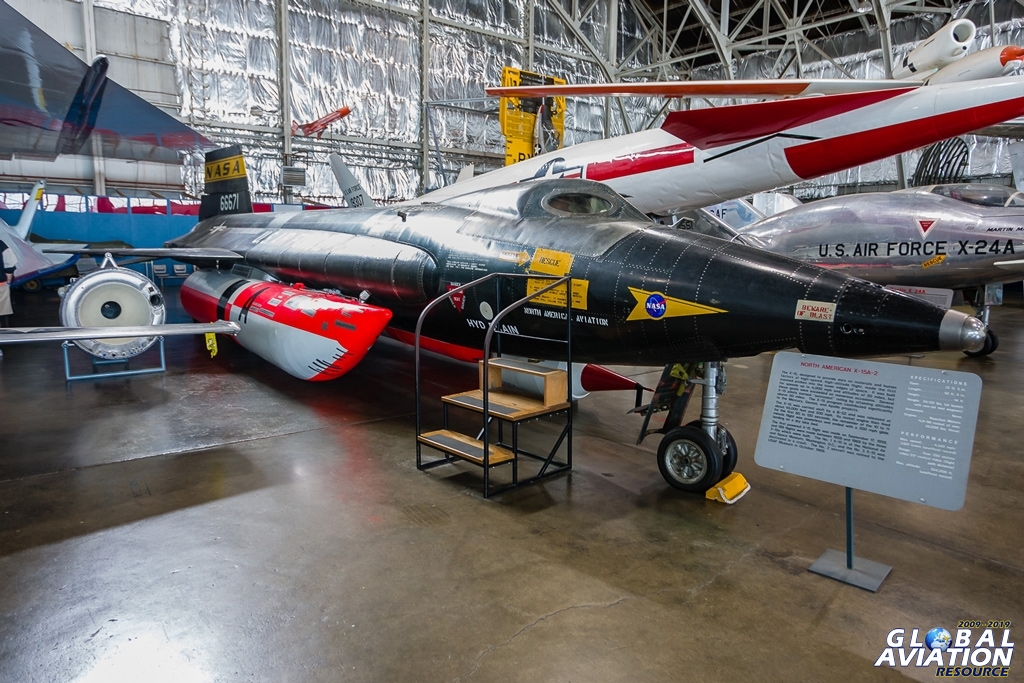
X-15 – 56-6671 – National Museum of the United States Air Force © Rob Edgcumbe – Global Aviation Resource
Armstrong was also a member of the USAF / NASA Dyna-Soar Pilot Consultant Group and studied approach and abort procedures for the extraordinary X-20 Dyna-Soar through use of the F-102A and Douglas F5D Skylancer. The X-20 was USAF’s multi-role spacecraft project and it’s preferred means for launching a manned military spacecraft into orbit.
The F-102 Delta Dagger was the backbone of the United States Air Force’s air defences and entered service in 1956. Its main purpose was to intercept Soviet strategic bombers during the Cold War. Designed and manufactured by Convair, 1,000 F-102s were built and it was the USAF’s first operational supersonic interceptor and first delta-wing fighter. Like many of the Century Series jets, numerous F-102s were transferred from active duty to the ANG and, with the exception of those examples that were converted to unmanned QF-102 Full Scale Aerial Target (FSAT) drones, used for air to air missile testing. the type was retired from operational service in 1976. It’s replacement was the Mach 2 capable Convair F-106 Delta Dart, essentially an extensively redesigned F-102.
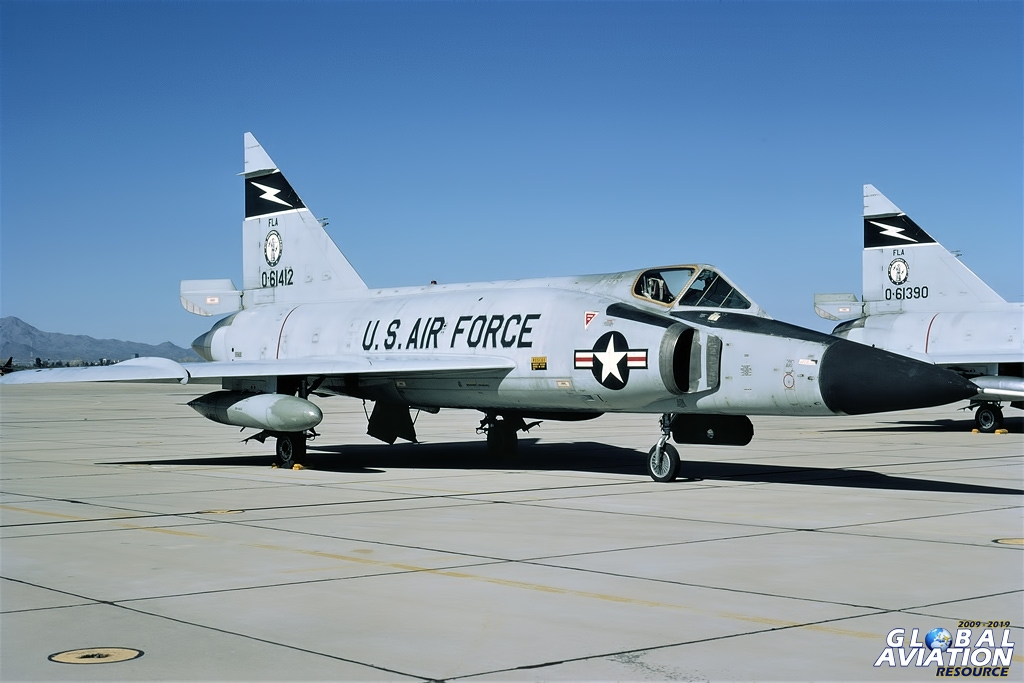
F-102A Delta Dagger – 061412 – Florida ANG – 10/69 © Lindsay Peacock – Global Aviation Resource
The Douglas F5D Skylancer was a development of the US Navy’s F4D Skyray jet fighter, but the Navy cancelled its order when just four aircraft had been built. These airframes remained in use for test purposes but while two were grounded in 1961 the others were transferred to NASA and continued to fly. The reason given at the time for the aircraft’s cancellation was that it had been deemed too similar to the Vought F8U Crusader already on order for the US Navy, but some historians believe that that politics played as significant a part in the decision, with Douglas seemingly moving ever closer to monopolising production of aircraft for the US Navy.
Notably, the project test pilot for the F5D Skylancer was Lt. Cmdr Alan B. Shepard Jr. and his report concluded that the aircraft would not needed by the Navy. Shepard would go on to be selected as one of the Mercury 7 and the first American in space. He would later walk on the moon as Commander of Apollo 14, becoming the fifth and oldest man to do so, and the only one of the original astronaut intake to achieve the feat.
Of the two Skylancer aircraft that continued to fly, NASA 708 was used as a test-bed for the American supersonic transport program and was fitted with an ogival wing (shaped with the profile of a pointed or Gothic arch, called an ogive) which was the type eventually used on Concorde and data from the American test program was indeed shared with European designers. NASA 708 was retired in 1968 and can now be found at the Evergreen Aviation and Space Museum in McMinnville, Oregon.
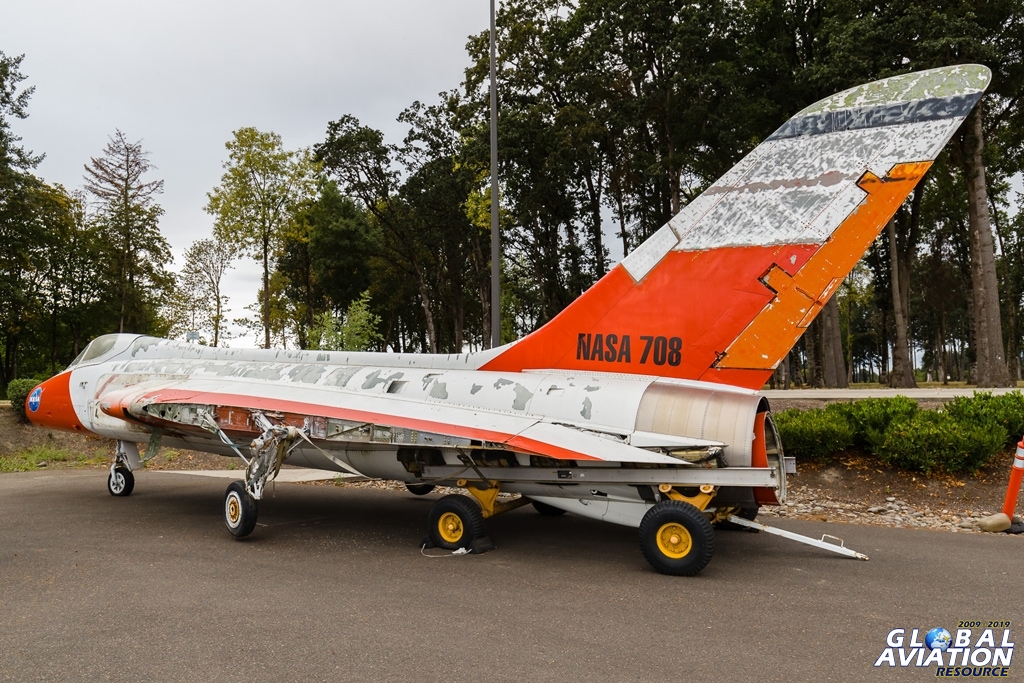
Sadly looking a little worse for wear – F5D-1 Skylancer #708 – Evergreen Aviation and Space Museum © Rob Edgcumbe – Global Aviation Resource
The other aircraft, NASA 802, was used to simulate abort procedures for the X-20 Dyna-Soar because it had a similar shape and handling characteristics to the proposed spacecraft (see gallery below). Following the cancellation of the Dyna-Soar project, before an example was even built, NASA 802 was used as a chase plane and for various other research programs until its retirement in 1970.
The aircraft now, most appropriately, sits on static display outside of the Neil Armstrong Air and Space Museum in Wapakoneta, the Ohio town where Neil Armstrong was born and grew up. The aircraft was restored in 2018.

Douglas F5D Skylancer following a test flight – NASA
Finally, Armstrong was also among a small group of test pilots who flew the Parasev, NASA’s Paraglider Research Vehicle. This was an unpowered, experimental glider aircraft based upon kite-parachute studies carried out by engineer Francis Rogallo, now credited with the invention of the ‘Rogallo wing’, the precursor to the modern hang glider and paraglider and which, in the 1960’s, had seemed like a perfectly suitable means of returning a spacecraft to Earth.
The Parasev 1-A was the result of that study and it was flown by just eight pilots. In addition to Armstrong this small group included two future members of the original Mercury 7, Gus Grissom and Deke Slayton.
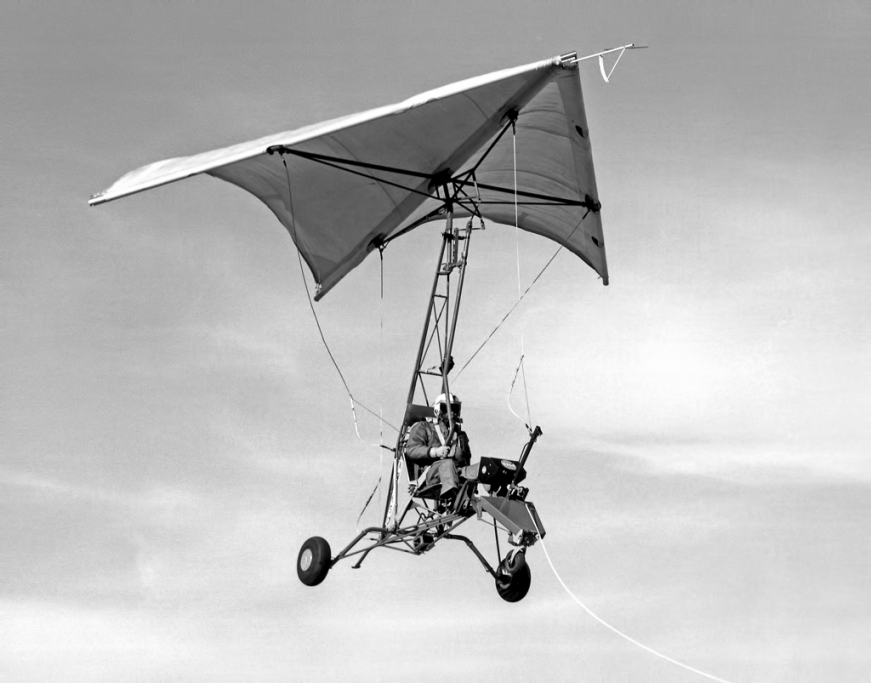
Parasev 1-A – NASA
Neil Armstrong left the Flight Research Center to join the astronaut corps with a total of 2,450 flying hours in more than 50 aircraft types. He went on to accumulate a total of 8 days, 14 hours, 12 minutes, and 30 seconds in space on Gemini 8 and Apollo 11, including two hours and 48 minutes walking on the moon.
He passed away in 2012.
Edwin “Buzz” Aldrin Jr – Lunar Module Pilot
Edwin Eugene Aldrin Jr was born in 1930 in Montclair, New Jersey, and graduated from the US Military Academy at West Point in 1951. Aldrin was a strong academic student at West Point and, as one of the highest-ranking members of his class, was allowed to choose his own post-graduation assignment. He chose the United States Air Force, was commissioned as a Second Lieutenant and started basic flight training in the T-6 Texan at Bartow Air Base in Florida.
On completion of his training, Aldrin’s father, who had been an Army aviator during World War I and was the Assistant Commandant of the Army’s test pilot school from 1919 until 1922, advised him to become a bomber pilot because, he believed, taking command of a bomber crew would give Buzz the opportunity to learn and hone his leadership skills, which could in turn improve his career prospects.

F-80B Shooting Star – Davis-Monthan – 11/69 © Lindsay Peacock – Global Aviation Resource
Aldrin ignored his father’s advice though and chose to fly fighters. He was posted to Nellis Air Force Base in Las Vegas, Nevada, where he learned to fly jets, namely the F-80 Shooting Star and the F-86 Sabre. The former was America’s first successful turbojet-powered combat aircraft. Designed by Kelly Johnson and built by Lockheed in 1943, the F-80 was delivered just 143 days from the start of the design process and two pre-production airframes saw limited service in Italy just before the end of World War II. Designed with straight wings, the type would go on to see extensive combat in Korea with the United States Air Force.
While the F-80 was at the cutting edge as America entered the jet age, it found itself rapidly outclassed by the appearance of the swept-wing F-86 Sabre. This aircraft is of course of great historical significance and is also strongly linked to the Apollo 11 crew as it was flown both by Aldrin and Michael Collins and indeed, Aldrin has been quoted as saying “I’m sure the most favorite airplane in my career would still be the F-86 Sabre, which allowed me to be credited with two Russian-built Mig-15s destroyed during the Korean War.”
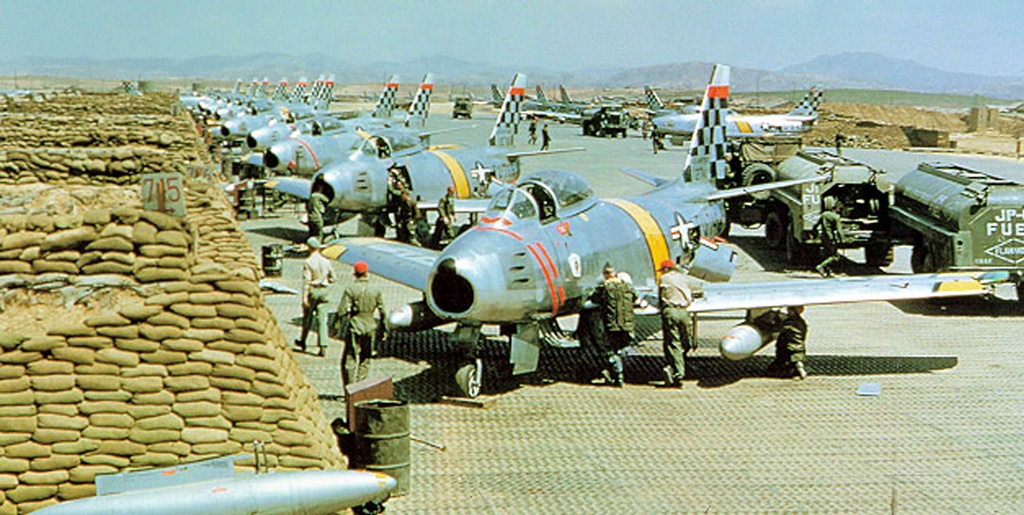
51st FIW flight line during the Korean War – USAF
The North American F-86 Sabre is probably best known as the USA’s first swept-wing fighter with enough performance to counter the similarly swept-wing Soviet MiG-15 that it would meet in numerous battles during the Korean War. These were some of the earliest jet-to-jet dogfights and the F-86 proved itself to be an extremely versatile and adaptable combat aircraft and saw front-line service until the last active operational examples were retired by the Bolivian Air Force in 1994.
The F-86 was the first American aircraft to take advantage of flight research data seized from German aerodynamicists at the end of World War II; data which showed that a thin, swept-wing would reduce both drag and the problems with compressibility that had beleaguered aircraft such as the Lockheed P-38 Lightning. Studies of the German data demonstrated that a swept-wing would solve speed problems (the prototype F-86, the XP-86, failed to reach the 600mph target set by USAF), while a slat on the wing’s leading edge that extended at low speeds would enhance low-speed stability.
Total production of all variants of the Sabre reached 9,860 aircraft and it undoubtedly remains an aviation icon and the most produced Western combat aircraft, manufactured not just in the United States but also in Japan and Italy, while licensed variants were built in Canada and Australia.
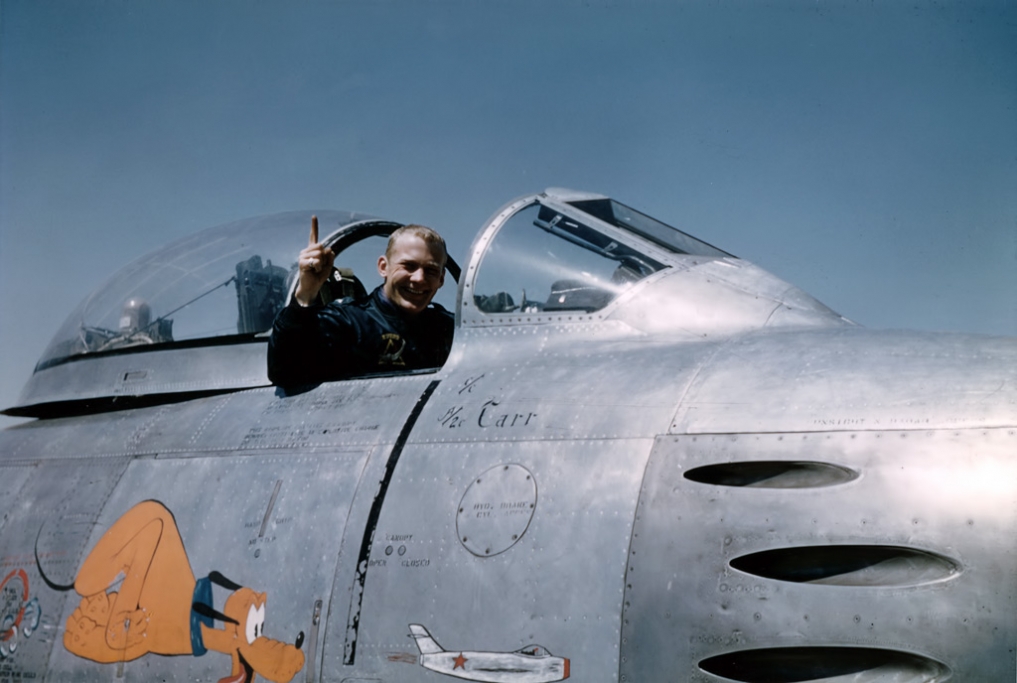
Lieutenant Buzz Aldrin, 51st Fighter Interceptor Wing, in the cockpit of a North American Aviation F-86E Sabre after shooting down an enemy MiG-15 during the Korean War – USAF
Aldrin completed his training and went on to become a fully-fledged Air Force pilot, flying 66 combat missions during the Korean War, where he flew the F-86 with the 51st Fighter Wing based at Seoul and shot down two MiG-15 aircraft. Aldrin’s first confirmed kill came on 14th May 1953 when he was flying about five miles south of the Yalu River.
Aldrin saw two MiG-15 fighters below him and opened fire on one of them, shooting it down. An issue of Life magazine in June 1953 featured the gun camera footage taken by Aldrin of the pilot ejecting from his damaged aircraft and we have included the imagery here. Aldrin later shot down another MiG-15 and was awarded two Distinguished Flying Crosses and three Air Medals for his service in Korea.

Still images from the gun camera film show an enemy pilot bailing out of a MiG 15 shot down by Lieutenant Buzz Aldrin, five miles south of the Yalu River, 14 May 1953 – USAF
Aldrin later served in West Germany and flew the nuclear-armed F-100C Super Sabre from Bitburg Air Force Base with the 22nd Fighter Squadron, 36th Fighter Wing. He then enrolled at MIT, the world famous Massachusetts Institute of Technology, and completed a doctorate in Astronautics, graduating in 1963. Later that year his second application to NASA was successful and he joined the astronaut corps as part of the third intake, along with Michael Collins.
Aldrin spent a total of 12 days, 1 hour and 53 minutes in space on Gemini 12 and Apollo 11.
Michael Collins – Command Module Pilot
Michael Collins also commenced his basic flight training in the T-6 Texan, but in August 1952 at Columbus Air Force Base in Columbus, Mississippi. He moved from there on to San Marcos Air Force Base in Texas for advanced flying training and lastly to James Connally Air Force Base in Waco, Texas for jet training.
Collins was awarded his wings on completion of the course at Waco in September 1953 and was one of the select group chosen to undergo advanced day-fighter training at Nellis Air Force Base, Nevada, flying the F-86 Sabre. As Collins remarks in his excellent autobiography ‘Carrying the Fire’, the training at Nellis was dangerous and eleven pilots were killed in the 22 weeks he was there; an extraordinary statistic.

F-86H Sabre – 31413 New York ANG 04/67 © Lindsay Peacock – Global Aviation Resource
His first operational posting came in January 1954 when he was assigned to the 21st Fighter Bomber Wing at George Air Force Base in California. Here he was taught to perform ground attack and nuclear weapons delivery techniques in the F-86F, and he remained with the unit when, in December 1954, it relocated to Chambley-Bussières Air Base in France. Collins managed to win first prize in gunnery competition in 1956 but during a NATO exercise that summer he was forced to eject from his F-86 after a fire started behind the cockpit.
Collins later commanded a Mobile Training Detachment (MTD) and travelled to air bases around the world; his detachment training mechanics how to service new aircraft and pilots how to fly them. This posting allowed him to accumulate over 1,500 flying hours, the minimum required for admission to the USAF Experimental Flight Test Pilot School at Edwards Air Force Base. Collins’ application was successful and in August 1960 he became a member of test pilot Class 60C which included Frank Borman, Jim Irwin and Tom Stafford, all of whom would go on to become astronauts.
Borman was the Commander of Apollo 8, the first mission to fly around the moon, and for Apollo 11 he was NASA’s liaison at the White House and watched the launch on television with President Nixon. Irwin would go on to serve as Lunar Module pilot for Apollo 15 and became the eighth person to walk on the moon while Stafford was the Commander of Apollo 10, the second manned mission to orbit the moon and the first to fly a Lunar Module in lunar orbit. Later he was the commander of the Apollo-Soyuz Test Project flight, the first joint US / Soviet space mission.
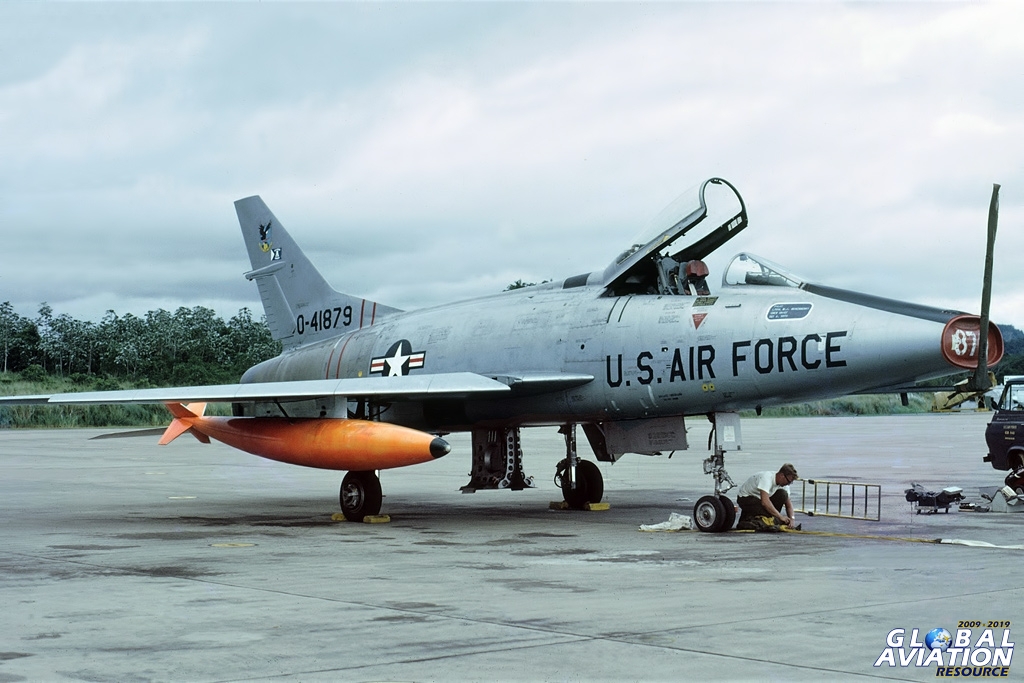
F-100C Super Sabre – Howard AFB – 04/79 © Lindsay Peacock – Global Aviation Resource
Instruction on the course started with the North American T-28 Trojan and proceeded through a selection of high performance aircraft such as the F-86 Sabre, B-57 Canberra, T-33 Shooting Star, and F-104 Starfighter. Collins would eventually end up with almost 5,000 flight hours as an experimental test pilot and published a number of reports on aircraft control and stability, his area of expertise.
In 1962, and with the space race well underway, the Experimental Flight Test Pilot School became the Aerospace Research Pilot School as USAF tried to secure a foothold into space research through the X-15 and X-20 programs. Collins applied for a place on a new postgraduate course into the basics of spaceflight and, having been successful, he and his classmates flew up to 90,000ft in F-104 Starfighters as part of the syllabus. As they passed through the top of their parabolic arc they experienced a momentary period of weightlessness. He wouldn’t have known at the time, but this was all useful experience for what was to follow!
Having already, like Aldrin, been turned down for the second astronaut intake, Collins was accepted into the third class and joined NASA in 1963, spending a total of 11 days, 2 hours, 4 minutes and 43 seconds in space on Gemini 10 and Apollo 11.

Michael Collins (L) and fellow astronaut Deke Slayton with a NASA T-38. It was on one such flight, from Houston to The Cape and just prior to Apollo 11 that Slayton, the astronauts’ boss, asked Collins if he would like to be assigned to a further mission, one that would probably have seen him walk on the moon, but Collins declined, having already decided to spend more time with his family. Collins did however tell Slayton that he would be banging on his door to secure a second attempt if Apollo 11 did not succeed – NASA
Finally, this piece would not be complete without a more than honourable mention of the Northrop T-38 Talon, an aircraft that links not just the crew of Apollo 11 but every single American astronaut, as NASA has operated a fleet of the aircraft as a jet trainer and chase plane since the 1960’s. The T-38 is a two-seat, twin-engined aircraft and was the world’s first supersonic jet trainer. It remains in service with several air forces and has been in service with the United States Air Force for more than 50 years.
As well as using it for training duties, astronauts made good use of the T-38 as a transport too, using the jets to fly between manufacturing and training sites as the space programmes developed, such as between Houston, Texas and Cape Kennedy in Florida – often just referred to as ‘The Cape’. As the Gemini and Apollo projects gathered pace, the T-38s were frequently the only way to allow crews to complete the tasks allotted to them, as using scheduled airline flights would have been too time-consuming and impractical. Neal Thompson, in his superb biography of Alan Shepard, ‘Light This Candle‘, says it was actually Shepard and Deke Slayton who persuaded their NASA bosses to acquire the T-38s to help with all their travelling.

NASA T-38 Talon © Paul Dunn – Global Aviation Resource
Collins talks of the T-38 in ‘Carrying the Fire’ and relates how, on the weekend of 12th and 13th July 1969 he went to Patrick AFB and flew two sixty minute sorties, one solo and one with Deke Slayton. He did this condition his inner ears ahead of Apollo 11 so that he might, hopefully, avoid sickness when weightless.
In the same book, one image of the jet is captioned “The T-38 – our teacher, our transportation, our toy.” A sentiment echoed, I am sure, by many other astronauts.
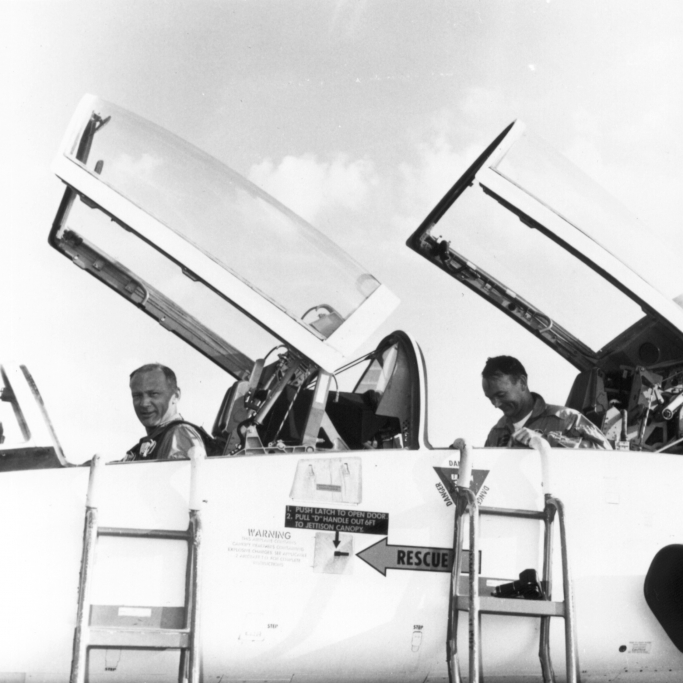
Buzz Aldrin (L) and Michael Collins on arrival at Patrick Air Force Base in a T-38 – NASA
This then is some of the background to the Apollo 11 crew and its roots in aviation.
They were three hugely experienced men who were able to bring together all the skills, courage and motivation needed to make Apollo 11 a success. Armstrong, Aldrin and Collins may not have been the cheeriest of the Apollo crews, which is a whole other story, but they shared passions that would undoubtedly help them to make history – a love of flight and a love of adventure – and 50 years ago they successfully completed one of the greatest flights and greatest adventures of them all.
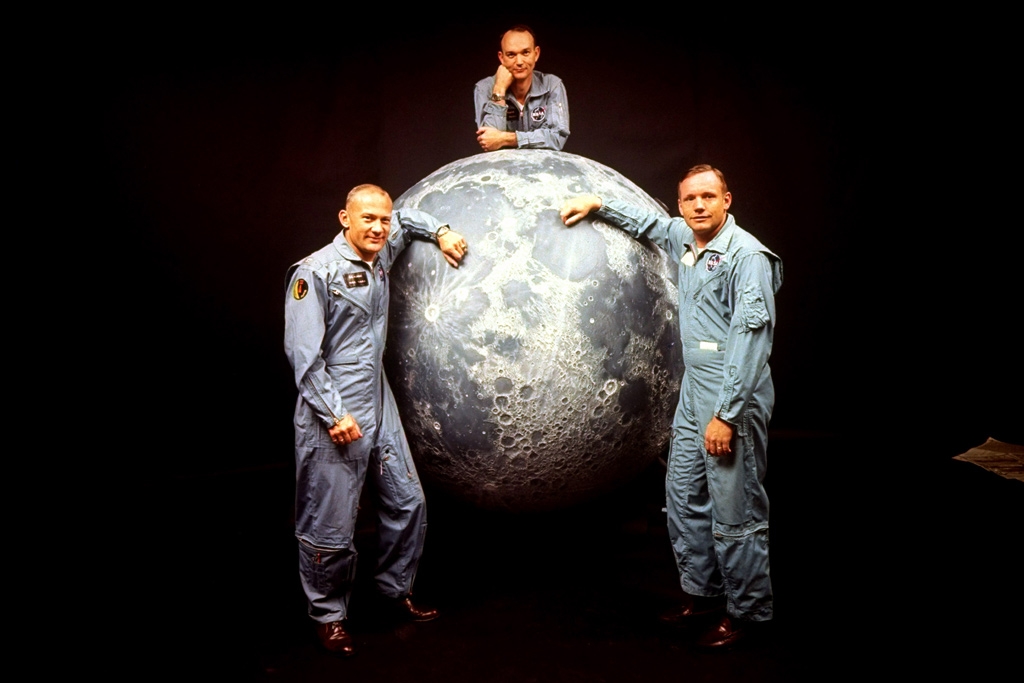
Apollo astronauts (L-R) Buzz Aldrin, Michael Collins and Neil Armstrong | Ralph Morse—The LIFE Picture Collection / Getty Images
Many thanks to everyone who assisted with imagery and information for this feature, especially Paul Hannah who was good enough to grant permission for us to use his image of the X-14.
Explore the gallery below for even more photos relating to this feature:


What a fantastic presentation –
I have forwarded it to many of my RAF friends
Thank you so much, Jeff. I really enjoyed putting it together – a once in a lifetime opportunity!
Great read Gareth. I can remember that time as a 10year old boy looking up at the moon as if it was only yesterday.
Thanks Jim. How I wish I had experienced it first hand!